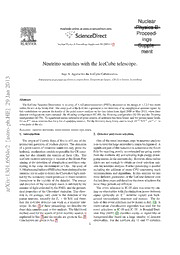
Neutrino searches with the IceCube telescope PDF
Preview Neutrino searches with the IceCube telescope
Nuclear Physics B Proceed- ings NuclearPhysicsBProceedingsSupplement00(2013)1–3 Supple- ment Neutrino searches with the IceCube telescope. JuanA.AguilarfortheIceCubeCollaboration. 3 1 De´partementdephysiquenucle´aireetcorpusculaire,Universite´deGene´ve,CH-1211Gene`ve,Switzerland 0 2 n a J Abstract 9 2 TheIceCubeNeutrinoObservatoryisanarrayof5,160photomultipliers(PMTs)deployedon86stringsat1.5-2.5kmdepth withintheiceattheSouthPole. ThemaingoaloftheIceCubeexperimentisthedetectionofanastrophysicalneutrinosignal. In ] E thiscontributionwepresenttheresultsofthepointsourceanalysisonthedatatakenfromApril2008toMay2011,whenthree H detectorconfigurationswereoperated: the40-stringconfiguration(IC-40),the59-stringconfiguration(IC-59)andthe79-string configuration(IC-79). Nosignificantexcessindicativeofpointsourcesofneutrinoshasbeenfound,andwepresentupperlimits h. foranE−2muonneutrinofluxforalistofcandidatesources. Forthefirsttimetheselimitsstarttoreach10−12TeV−1cm−2s−1in p somepartsofthesky. - o Keywords: neutrinoastronomy,point-sources,cosmicraysorigin r t 1. Introduction 2. Detectorandeventselection. s a [ The origin of Cosmic Rays (CRs) is still one of the Oneofthemostimportantstepsinneutrinoanalysis unresolvedquestionsofmodernphysics. Thedetection istoremovethelargeatmosphericmuonbackground.A 2 ofapointsourceofneutrinoscouldnotonlyprovethe significantpartofthisreductionisachievedattheSouth v 4 hadronicaccelerationmodelsresponsibleforCRemis- Polebyrejectingpoorlyreconstructedup-goingevents 0 sion but also identify the sources of these CRs. The fromthenorthernskyandselectinghighenergydown- 5 IceCubeneutrinotelescopeislocatedattheSouthPole goingmuonsinthesouthernsky. However,theseonline 6 aimingatthedetectionofastrophysicalneutrinosorig- filters are not enough to obtain an event selection suit- . 1 inating in the same environment as CRs. An array of ableforneutrinoanalysis. Furtherprocessingisneeded 0 5,160photomultipliers(PMTs)hasbeendeployedinthe including the addition of more CPU consuming track 3 antarcticiceinordertodetecttheCherenkovlightemit- reconstructionsandalgorithms. Inthisanalysisweuse 1 tedbythesecondarymuonproducedinmuonneutrino threedifferentgeometriesoftheIceCubedetectorover : v interaction in the vicinity of the detector. The energy thelastthreeyearsandthereforetheeventselectionsfor Xi and direction of the secondary muon is inferred by the thesethreeperiodsaredifferent. amountoflightcollectedbythePMTsandthegeomet- The event selection in IC-40 data was done by cut- r a ricalpropertiesoftheCherenkovemission. Thisdirec- tingonobservableswithdiscriminationpowerbetween tion is, on average, very close to the direction of the signal (generally an E−2 neutrino signal) and back- parent neutrino, specially for E > 10 TeV, and there- ground (atmospheric neutrinos and muons). The de- ν fore the IceCube detector can work as a neutrino tele- tailsofthiseventselectioncanbefoundinRef.[1]. A scope. In Sec. 2 of these proceedings we describe the multi-variate classification algorithm was used for the threedatasamplesusedinthisanalysis. Thelikelihood event selections in IC-59 and IC-79. A Boosted Deci- methodusedforthesearchofpointneutrinosourcesis sion Tree (BDT) [2] classifies events as signal-like or explained in Sec. 3 and the results are given in Sec. 4. background-like based on a large number of detector ConclusionsaregiveninSec.5. observables. For the northern sky 12 and 17 variables 1 /NuclearPhysicsBProceedingsSupplement00(2013)1–3 2 using simulation and scrambled real data, respectively. Sincethreegeometriesandeventselectionswerecom- bined, thedensitydistributionoftheith eventinthe jth samplewithenergyE anddistancetothesource|x−x |, i i s isgivenby: Pij(|xi−xs|,Ei,γ,nsj)= NnsjjSij+1− NnsjjBij, (1) where j represents the three different event selections, IC-40, IC-59 and IC-79. The total number of events in the jth data set, Nj, satisfies the condition N = tot NIC40 + NIC59 + NIC79, where N is the total number tot of events in the three samples. The signal is consid- ered to follow the uniform hypothesis among data sets and therefore the spectral index meets the condition of Figure1.MuonneutrinoeffectiveareasatfinalcutlevelfortheIC-79 γ = γ . The fitted number of signal events nj in each j s periodforsixdeclinationbands(solid-angle-averaged)asafunction samplearealsofixedrelativetoeachother,accordingto oftheneutrinoenergy. thesignalhypothesistestedandtheresultingfractionof Conf. Year t [days] SMT[Hz] R totalsignaleventsexpectedineachsample. Fortheall- live ν 40 2008 376 1100 40/day skysurvey,thelikelihoodisevaluatedineachdirection 59 2009 348 1900 120/day intheskyinstepsof0.1◦×0.1◦centeredattheposition 79 2010 316 2300 180/day of the source xs. The significance of any excess found inthenorthernskyiscorrectedfortrialsbydetermining Table1.EventratesfordifferentIceCubeconfigurations.Firstcolumn thefractionofscrambleddatasetswhichcontainanex- isthenumberofstringsintheconfiguration.Theyearofoperationis cessofequalorhighersignificancealsointhenorthern showninthesecondcolumn. Thelive-timeindaysisgiveninthe part of the sky. Likewise, the most significant excess thirdcolumn. Therateattriggerlevel(SimpleMajorityTrigger)is showninthefourthcolumnwhilethelastcolumnshowsthenumber found in the southern sky is reported and the post-trial ofup-goingevents(mainlyatmosphericneutrinos)afterthefinalcut. significanceiscalculatedbycomparingitwiththefrac- tion of scrambled data sets with an excess of equal or highersignificanceinthatpartofthesky. were used in the BDT training for the IC-59 and IC- 79periods respectively. Thesouthernskyin theIC-59 4. Results datasetwas,however,filteredusingacutontheenergy estimatorasafunctionofthezenithangletoseparatethe The results of the all-sky scan are shown in the pre- large amount of down-going atmospheric muons from trialsignificancemapinFigure2. Themostsignificant a hypothetical neutrino signal with a harder spectrum. deviation in the northern sky has a pre-trial p-value of In the IC-79 dataset a combination of a BDT cut and 1.96×10−5 andislocatedat34.25◦ r.a. and2.75◦ dec. a zenith dependent energy cut was applied. Figure 1 Similarly,themostsignificantdeviationinthesouthern shows the muon neutrino effective area of the IC-79 skyhasapre-trial p-valueof8.97×10−5andislocated sample for different declination bands as a function of at 219.25◦ r.a. and −38.75◦ dec. The post-trial proba- theneutrinoenergy. bilitiescalculatedasthefractionofscrambledskymaps Thedifferentdataratesforthethreeperiodsatdiffer- with at least one spot with an equal or higher signifi- entlevelscanbeseeninTable1. canceforeachregionoftheskycorrespondto57%and 98%forthenorthernandthesouthernspotsrespectively andthereforebothexcessesarewellcompatiblewiththe 3. Likelihoodmethodforpointsourcesearch backgroundhypothesis. Inthissearchanunbinnedmaximumlikelihoodratio Figure3showstheE−2muonneutrinofluxupperlim- test [3] was used in order to calculate the significance its calculated at 90% C.L. based on the classical (fre- of an excess of neutrinos above the background for a quentist)approach[4]foreachofthesourcesonacan- given direction in the sky. The signal (S) and back- didatelist. Alsoshownisthemedianupperlimit(sen- ground (B) probability density functions are modeled sitivity) for each declination for a live-time of 1,040 2 /NuclearPhysicsBProceedingsSupplement00(2013)1–3 3 Figure2.Significanceskymapinequatorialcoordinates(J2000)oftheall-skypointsourcescanforthecombinedIC79+IC59+IC40datasample. Thedashedlineindicatesthegalacticplane. 5. Conclusions We presented the results of the point source analy- sis using the data-sets corresponding to three different IceCubeconfigurations. Thecombineddatahasatotal live-time of 1,040 days. The search for neutrino point sources found no evidence of a neutrino signal. Both the north and the south hot spots have post-trial prob- abilitiescompatiblewithbackgroundfluctuations. The muon neutrino upper limits presented here are a factor ∼ 3.5 better than the latest published upper limits by IceCube[1]andarethemostcompetitiveneutrinolim- itstodateoverthemajorityofthesky. References Figure3.Muonneutrinoflux90%C.L.upperlimitsandsensitivities [1] R.Abbasietal.[IceCubeColl.],Astrop.J.,732(2011)18. foraE−2spectrum.PublishedlimitsofANTARES[5]areshown. [2] S.S.Kerthietal.,NeuralComp.13(2001)637. [3] J.Braunetal.,Astropart.Phys.,33(2010)175. [4] J.Neyman.Phi.Tran.oftheRoyalSoc.ofLondonSerA,236 (1937)333-380. days and the discovery potential flux for a 5σ confi- [5] S.Adria´n-Mart´ınezetal.[ANTARESColl.],SubmittedtoAs- dencelevel. The90%C.L.muonneutrinoupperlimits trop.J.,(2012)arXiv:1207.3105 andsensitivitiesfromANTARES[5]correspondtothe analysisof813daysofdata. 3
